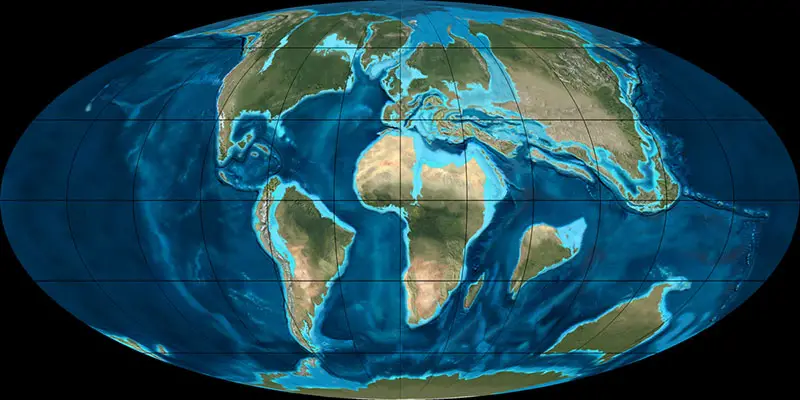†Tinimomys (Micromomyidae)
Tinimomys ist eine Primatengattung innerhalb der Familie Micromomyidae, deren 3 Mitglieder ab dem frühen Paläogen (Paläozän) im Thanetium lebten, das vor ungefähr 59,2 Millionen Jahren begann und bis vor 56 Millionen Jahren andauerte. Viele Überreste wurden in Vereinigte Staaten von Amerika (USA) gefunden.
Tinimomys ist der Gattungsname von zwei Primatenarten (T. graybullensis, T. loomisi) aus der Unterfamilie Micromomyinae (Familie Microsyopidae), die im vom späten Paläozän bis ins frühe Eozän in Nordamerika verbreitet waren.
Die Funde sind zwischen 56,8 und 48,6 Millionen Jahre alt.
Tinimomys graybulliensis
Das Typusexemplar hat die Bezeichnung PU No17899, dabei handelt es sich um einen linken Oberkiefer mit fragmentarischen Prämolaren und Molaren (P4-M2).
| Sammlung | Kommentar zum Fundort | Epoche, Alter | Geologie, Formation | Kommentar zur Sammlung |
|---|---|---|---|---|
| Discovery Site | Willwood | SC-29 | ||
| Lithographie | Museum | Kommentar z. Taxonomie | ||
| lens J "is a mottled micritic muddy limestone (wackestone) including gastropod shell fragments, plant debris, and vertebrate bone" that is "brown in unweathered hand specimens" | UMMP | the entire original list applies only to lens J |
| Physiologie | |
|---|---|
| Gewicht: | ? |
| Schwestertaxa | |
Tinimomys loomisi
Das Typusexemplar heißt UCM 48544, ein Unterkieferfragment mit den rechten Backenzähnen (M1-3). Basierend auf der Morphologie der Zähne schätzt man das Körpergewicht von Tinimomys loomisi auf 29,8 Gramm.
Literatur
F. S. Szalay 1974, A new species and genus of early Eocene primate from North America. Folia Primatologica. 22, p. 243 - 250T. M. Bown 1979, New Omomyid Primates (Haplorhini, Tarsiiformes) from Middle Eocene Rocks of West-Central Hot Springs County, Wyoming. Folia Primatologica. 31, p. - 250
D. M. Schankler 1980, Faunal Zonation of the Willwood Formation in the Central Bighorn Basin, Wyoming. University of Michigan Papers on Paleontology. 24, p. 99 - 114
K. D. Rose 1981, The Clarkforkian Land-Mammal Age and Mammalian Faunal Composition Across the Paleocene-Eocene Boundary. University of Michigan Papers on Paleontology. 26, p. 1 - 197
K. D. Rose, T. M. Bown 1982, New Plesiadapiform Primates from the Eocene of Wyoming and Montana. Journal of Vertebrate Paleontology. 2:1, p. 63 - 69
D. W. Krause, T. M. Bown 1986, . Contributions to Geology, University of Wyoming Special Paper. 3:1, p. - 69
P. D. Gingerich, T. M. Bown 1987, Early Eocene bats (Mammalia, Chiroptera) and other vertebrates in freshwater limestones of the Willlwood Formation, Clark's Fork Basin, Wyoming. Contributions from the Museum of Paleontology, University of Michigan. 27:11, p. 275 - 320
K. C. Beard, P. Houde 1989, An unusual assemblage of diminutive plesiadapiforms (Mammalia, ?Primates) from the early Eocene of the Clark's Fork Basin, Wyoming.. Journal of Vertebrate Paleontology. 9:4, p. 388 - 399
K. D. Rose, K. C. Beard, P. Houde 1993, . Annals of Carnegie Museum. 62:4, p. - 399
P. Robinson, K. C. Beard, P. Houde 1994, Myrmekomomys, a new genus of Micromomyine (Mammalia, ?Microsyopidae) from the lower Eocene rocks of the Powder River Basin, Wyoming. Contributions to Geology, University of Wyoming. 30:1, p. 85 - 90
W. C. Clyde, K. C. Beard, P. Houde 1997, Stratigraphy and mammalian paleontology of the McCullough Peaks, northern Bighorn Basin, Wyoming: Implications for biochronology, basin development, and community reorganization across the Paleocene-Eocene boundary. PhD Thesis, University of Michigan. :1, p. - 90
S. G. Strait, K. C. Beard, P. Houde 2001, New Wa-0 mammalian fauna from Castle Gardens in the southeastern Bighorn Basin. University of Michigan Papers on Paleontology. 33:1, p. 127 - 143
J. Alroy, K. C. Beard, P. Houde 2002, Synonymies and reidentifications of North American fossil mammals. . :1, p. - 143
S. G. B. Chester, K. C. Beard, P. Houde 2012, New micromomyid plesiadapiforms (Mammalia, Euarchonta) from the late Paleocene of Big Multi Quarry, Washakie Basin, Wyoming. Annals of Carnegie Museum. 80:2, p. 159 - 172
